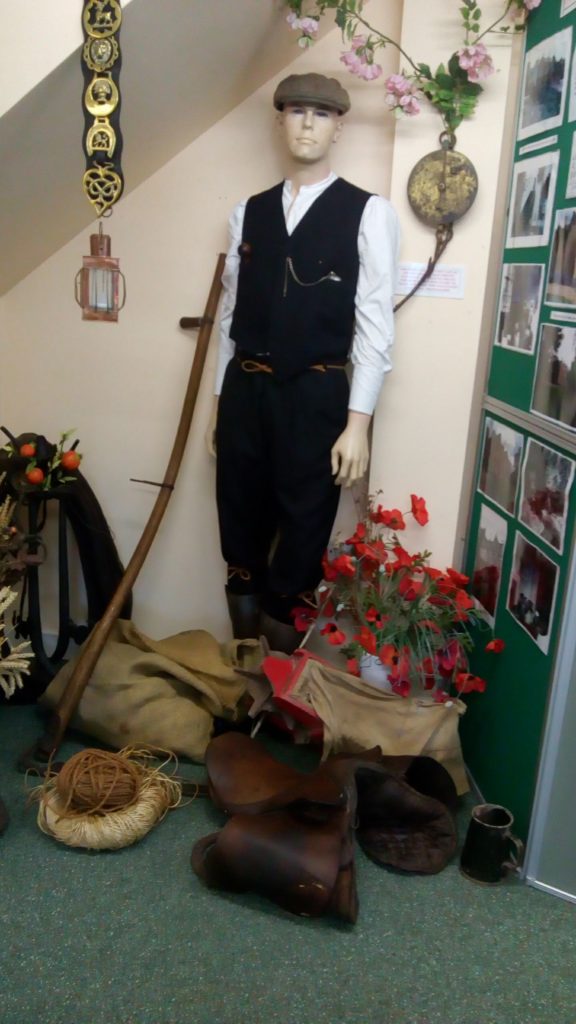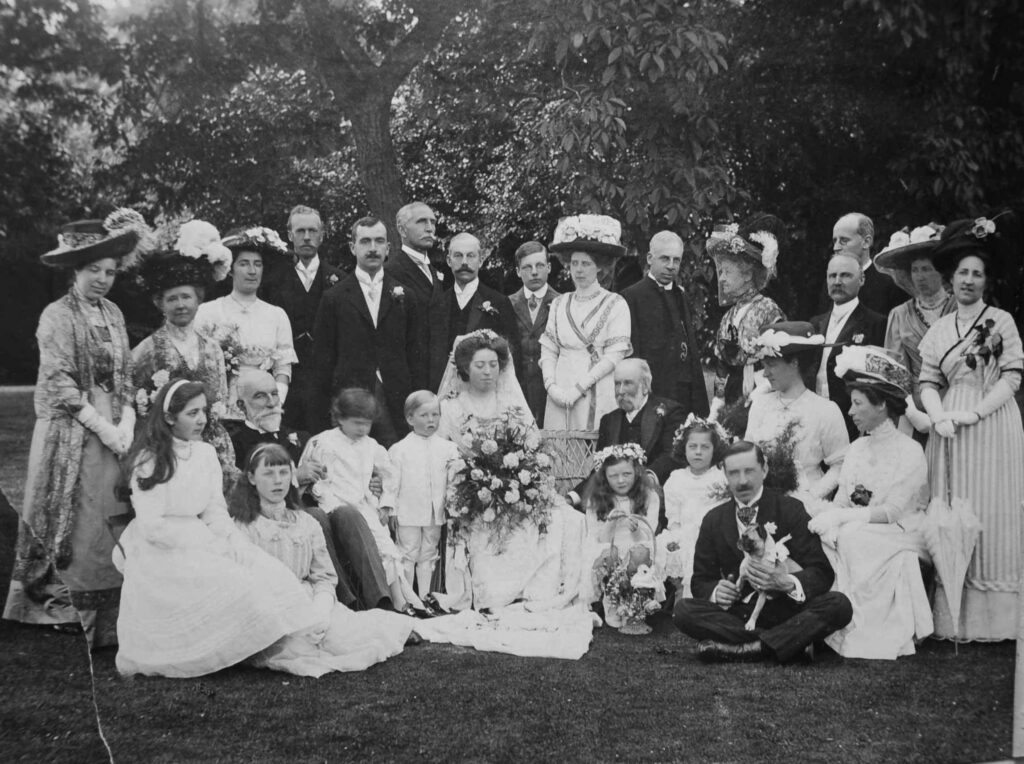June 2019 – May 2020 Upstairs Downstairs
This exhibition concentrated on the lives of the servants and their masters during the Victorian and Edwardian era.
One and a half million British people worked as servants at the beginning of the Edwardian era, that means one in four people were employed as a domestic servant, and most were women.

Servants often worked seven days a week, from as early as 5 am until as late as 10 or 11 pm, for very low wages. They were occasionally given a half-day off once a week, but sometimes employers didn’t allow even that. Most servants did not work in big stately homes full of fellow workers and camaraderie, but in a middle class town house or farm as the only servant. Instead of enjoying a lively dinner after serving the family upstairs, these servants would live and eat alone.

A kitchen maid’s salary was slightly more than that of the scullery maid and would have worked from 6.30am until 9.30pm with one afternoon off per week. The kitchen maid ranked below a cook and above a scullery maid. An experienced kitchen maid is an assistant cook.
June 2013 – April 2014 -The Emergency Services

As a small market town it was well into the 19th century before Bromyard had a properly controlled Police Force and the previous Union Workhouse was later extended and improved to provide medical facilities for the locality. As for the Fire Service the town had one small appliance which is now housed by the National Trust and is a far cry from the sophisticated response we receive today. These services which today we take for granted will be followed through the past century and a half with the help of contemporary photographs and documents; newspaper stories such as the devastating fire at Cheyney Court at Bishops Frome in 1888, and Thomas Powell of Thornbury who had his arm amputated after a farming accident. It is also hoped to make good use of our mannequins to provide real-life settings of the situations which faced those stalwart guardians of our local health and well being in days gone by.
June 2012 – June 2013 Celebrating the 1950s

A fascinating insight into life in the 1950s in our local area. Visitors were able to study photograpgs, posters, adverts and objects focused on everything from the Queen’s coronation to fashion, homelife and more.
May 2011- June 2012 Bromyard & District in 1911
The theme of this display by the Bromyard & District Local History Society was based on the recently published 1911 National Census. We discovered what was happening 100 years ago in Bromyard and in the surrounding parishes (35 in all!). There were exhibits on fashion, social activities for George V’s Coronation, and family life of the period including Society weddings at Brockhampton and Much Cowarne . The Census entries – the most detailed of any produced up to that time – were matched with photographs of family members and the places where they lived, some of which are still recognisable today.

The wedding of Christobel Bourne at Cowarne Court 1911
2010- April 2011 -Bromyard – it’s Buildings, Inside Out & The Victorian and Edwardian Tradespeople
In the Domesday Survey of 1086, Bromyard was recorded as a large agricultural manor held by the Bishop of Hereford.
There were two priests and a chaplain who would have ministered to a large surrounding area or ‘parochia’ of the church.
There was then no mention of the town.
The Saxon minster church had already been in existence for some considerable time, being recorded as early as 840. It was situated on high ground close to two crossing places of the R. Frome at Broadbridge and Petty Bridge where ancient roads converge and from an early date, men would have brought their produce here to trade. A small village probably clustered round this core.
The Saxon minster church had already been in existence for some considerable time, being recorded as early as 840. It was situated on high ground close to two crossing places of the R. Frome at Broadbridge and Petty Bridge where ancient roads converge and from an early date, men would have brought their produce here to trade. A small village probably clustered round this core.
Richard de Capella, Bishop of Hereford 1121 – 1127, was an experienced administrator who tried to improve the financial position of the diocese. He is the man who is thought to be responsible for the foundation of the planned town. The rents and market tolls thus generated would have been a profitable enterprise for the Bishop.
In 1280, after only some 160 years, a survey was carried out of the Bishop’s estates known as the Red Book and this shows an established town at Bromyard with 7 streets and a ‘seldae’ or Market Square, much larger than today’s Square. The survey was carried out street by street with each street name being followed by the names of the burgage holders and their holdings. There were 230 named tenants who held whole, parts or multiples of burgages. The layout of High Street and Broad Street, with their long burgage plots on each side was arranged in an unusual curve that reflected the church precinct. It is probable that there was a first phase of burgage plot layout that stopped on the line of Frog Lane and that the development to the east on both sides of Broad Street and the Market Square itself constitutes a later, separate phase of expansion extending to meet the north-south road of Sherford Street/Church Street, known in the late 13th century as Veteri Vico (Old Street).
These ancient houses and shops have been rebuilt, divided, altered, and refaced according to commercial & domestic need and fashion throughout the centuries.
This survey has been carried out by Duncan James in the heart of the ancient borough, in Broad Street, High Street and the Market Square. It was commissioned by the Local History Society and funded by Awards for All. The object was to investigate a range of buildings with a view to understanding their phasing, design and where possible, their original and subsequent function. It has allowed patterns of building that are possibly unique to Bromyard to be identified. The exhibition displays many new unpublished photos.
Apart from two 15th century buildings, the early buildings date in the main, from the late 16th to the early 17th century. This is similar to the Ledbury pattern although the Bromyard houses of this period seem to be of a greater variety in terms of design. In Bromyard there is no doubt that there was a significant period of timber-frame construction, both before and after 1600 as there are at least 50 houses in the central area that contain structural material from this period, some of which is visible although the majority is now hidden behind later facades.
Town buildings are far more vulnerable to destructive changes, although towns are also the source of finance and the stimulus for new houses and Bromyard has many good examples of these from the 18th and 19th centuries.
The Victorian and Edwardian Tradespeople
The second part of the Exhibition concentrates on the late 19th and early 20th century shopkeepers, publicans, and other tradesmen who lived and worked in Bromyard in the days when it was a buzzing market town serving its agricultural hinterland.
For more details regarding exhibitions please contact Mandy Palmer at: The Local & Family History Centre, 5 Sherford Street, Bromyard, Herefordshire, HR7 4DL or by email at exhibitions@bromyardhistorysociety.org.uk
